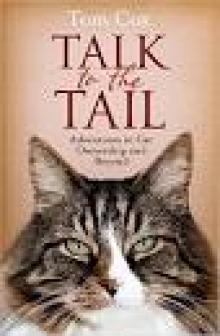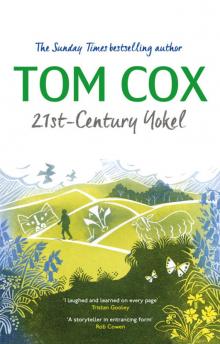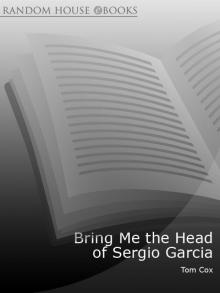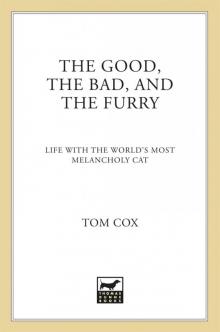Bring Me the Head of Sergio Garcia Read online
Page 2
I wouldn’t exactly call Jerry a close friend, but in the months leading up to May 2005 I had come to look upon him as a benevolent golfing presence. Maybe if the two of us bumped into one another at the local supermarket we would have said a quick hello and been on our way, but within the confines of our golf club, we were allies: if not crusaders against the tucked-shirt masses, then kindred outsiders looking in, perplexed, at the fishbowl that contained the Sunday fourball elite. Since my return to golf, I’d noticed that a lot more men like Jerry played the game: fiercely competitive, football-loving, straightforward blokes in their late thirties whose love of golf had nothing to do with cheaply engraved cut glass or reserved parking spots or blazer badges. To Jerry, golf was like any other sport, only better, and he had decided that waiting until the age of thirty-three to start wasn’t going to stand in his way of being bloody good at it.
Jerry said it was depressing, being him, and playing with me. There he was, hitting the practice ground four times a week, chipping slowly away at his fifteen handicap, while this scruffy, fly-by-night, once-a-fortnight chancer pulled into the car park three minutes before his tee time and proceeded to nonchalantly accumulate birdies. What Jerry didn’t know was that he was my lucky charm. Somehow, with him at my side, the Tom that I flattered myself was the ‘real Tom’ would come effortlessly to the fore, easing into his drives like an only slightly more ungainly Fred Couples.
Being a competitive sort, with a manner as austere as his grade-one haircut, Jerry would very rarely comment on my good play, but I could tell that he was monitoring me. If I told him about a monumental drive I’d hit the previous week, he would mysteriously have heard about it on the club grapevine. ‘Yeah. 320 yards. Nine-iron into the green. I know,’ he’d say. Seemingly unimpressed, he’d quickly deflect the conversation back to his attempts to cure his violently hooking long irons. But one day, in May 2005, his equilibrium cracked.
On the long par-four fourteenth, a new ‘freewheel through the ball’ swing thought helped send my drive hurtling into a realm that it was assumed only John ‘Smasher’ Briggs, the club’s ex-assistant pro, could reach. I charged off the tee in overexcitable, somewhat disbelieving pursuit, but Jerry stopped behind me.
He was leaning on the tee marker, and he had a tiny crooked smile playing about the corner of his mouth. ‘So, have you ever really thought about it?’
‘Thought of what?’ I asked.
‘Turning pro. Making a go of it. Living the life.’
‘I did once, but it’s sort of too late now. Anyway, I’m not good enough.’
‘But you only play once or twice every two weeks, and you play like this. What if you came up to the course more? Do you realise how many people would love to hit the ball that well? I tell you, Tom, I’ve been to The Open twice now, and I’ve seen those guys hit it, and I’ve seen you hit it. It makes the same sound.’
‘But that’s only part of it, isn’t it, the sound? What about the putting, and the chipping?’
‘I’m telling you, mate, big hairy balls to the putting. Arse to the chipping. You’ll sort that. I reckon there’s a handsome living out there for you. I know what I’d be doing, if it was me. I wouldn’t be fucking around here, writing for the Eastern Daily Press.’
‘But I don’t write for the Eastern Dai …’
‘Potaytoe, potahtoe. Who wants to be pissing around slaving over a typewriter for a living, or one of them laptop thingies or whatever it is you use, when they could be hanging out with Tiger Woods? I’m telling you, mate, now’s the time. You’re still young. If you’ve been given something great in life, you should do something with it, that’s what I always say.’
Plenty of people had told me, since my golfing reincarnation, that I ‘should be on Tour’. I knew that was sheer misguided flattery, and I knew about the huge gap between a four-handicap amateur like me and even the worst touring pro. Coming from someone like Jerry, however, the enthusiasm seemed to mean so much more. Clearly he wasn’t the kind of bloke who gave away compliments lightly. But what really affected me was his indignation. To him, my lack of interest in my golfing talent seemed scandalous, an insult to those who struggled along, barely getting the ball 200 yards off the tee. Maybe it was because I was on the verge of my thirtieth birthday, but in the weeks that followed I found myself marinating in his comments.
Everyone tells you that reaching thirty is a big deal, but nothing can prepare you for the event itself. I used to think that twenty-seven sounded old, and that after that landmark ages would all be much of a muchness, but thirty is an eloquent slap in the face. Suddenly, a considerable portion of the endless unfurling ‘future’ that you’ve been talking about for much of your twenties has already passed. I had been determined not to let it bother me. I’d even grown my first full beard especially for the occasion. After all, what was there to worry about? I was happily married, I had friends I could count on (even if most of them thought I was a bit weird for playing golf), I had a writing job that I loved, and I had a mortgage on a house that, two years after I had bought it, could still make me go ‘Wow!’ Still, when the big day itself hits, it’s impossible for even the happiest person not to do a bit of evaluating, ask themselves a ‘What if?’ or two. And, for me, the big ‘What if?’ was always golf.
Seventeen is an awfully young age to make any major decision about your life. But that was how old I’d been when I’d walked off a golf course as a budding pro golfer for what I believed, with all my broken heart, would be the last time. The scene of my exit has stuck with me – probably more like a memory of a memory now, but no less clear for that. The place: a forest in Staffordshire. The tournament: The Beau Desert Stag. My ball: abandoned (by hand and not, for once, by club) in some heather 400 yards behind me. My hands: sticky and callused. The smell: hot pine needles. My hat hair: not much of a hairstyle in the first place but now, if anything, looking more like two separate non-hairstyles. My golfing dreams: gone up in smoke. It had been one of those occasions when you can almost hear the click as your life changes direction. That night I would attend a rock concert – not a very cool rock concert, or even a very great one, but one loud and energetic and different enough to suggest that there might be another life out there for me that didn’t involve spiked shoes and winner’s speeches. In the days following, golf would never seem quite as important. Soon, as I stopped playing altogether, it would seem like an aberration at best, a dirty secret at worst. I remembered it like a brief schizoid episode: something that had nothing to do with the real me.
But now here I was – a fully-grown man, and still only a half-grown golfer. I definitely felt like the real me, yet I also couldn’t help feeling, just as I had at seventeen, that the secret to life itself was held in that lightning second when the body waits for the club and everything arrives at the ball in perfect sync. I’d initially told myself that my golfing rebirth was to do with getting fit and researching my golf memoir, Nice Jumper. And that is all it had been … for about a month or two. But in 2003, my first full year back playing, I had won my club’s Scratch Cup. Increasingly, I would arrive home from the course and explain to my bewildered wife, Edie, in the manner of a man outlining plans for his family’s financial future, that I thought all I really needed was to curtail my backswing by five inches and we’d be just about there. Maybe I was not playing golf with quite the obsessive fervour with which I’d played it as a teenager, but it would not have have taken a genius to see that this was about more than fresh air and a bit of gentle, competitive fun, and that something long-submerged was pressing to the surface. In short, I had begun to ask myself a little question.
Who really knows who they are at seventeen? Had I really given golf a proper go back then? It wasn’t as if I’d started playing as soon as I’d learned to walk, like many kids I’d known back on the Nottinghamshire golf scene. I’d actually come to the game quite late, and left it quite early. I’d been pretty good for those four and half years, too, hadn’t I? Within a couple of ye
ars, I’d become Club Champion at my home course, Cripsley Edge, the winner of a dozen junior competitions and one of the very best young golfers in Nottinghamshire, if not quite in the Midlands. But by the time I’d reached my seventeenth birthday, it had become abundantly clear that I wasn’t good enough: that two handicap of mine just wasn’t getting any lower, and, as I struggled to combine late nights in a minimum-wage job with early mornings on the tee, I could see the interest dying in the eyes of the men in the bile-coloured suits who patrolled the fairways looking for young talent. I’d only ever been a half golden boy in the first place, but now I was an ex-half golden boy. I was also one with some appalling GCSE results and two very anxious parents.
That period had felt like a mini-lifetime while it was happening, but what was four and a bit years, from a properly adult respective? It could take four and a bit years to unpack all your possessions after moving house, to fully settle into a new job, to untangle yourself from an unsuccessful relationship … to get round to mending a garden fence.
Could it be true? Had I been a bit rash on that hot day all those years ago in Staffordshire?
I’d seen older friends go through similar epiphanies. Upon reaching thirty, it had suddenly dawned on them that, no, at sixteen stone, with a mortgage and a steady job in the civil service, perhaps they weren’t going to fulfil that dream of playing on the right wing for Nottingham Forest after all. My predicament, however, was slightly different. Footballers (goalkeepers and Teddy Sheringham excepted) may be washed up at thirty, but, as of May 2005, the average age of the top fifty players in golf’s world rankings was 32.06. I actually had two full years until I was due to hit my peak! Granted, most 32.06-year-olds on the PGA Tour had spent their twenties hitting three hundred balls per day and playing high-level tournament golf forty weeks a year, rather than hanging around with rock musicians and drinking too much, but it was important not to quibble. There was a plentiful supply of hope here.
Also, hadn’t my decision to leave my pro golf ambitions behind been based, at least in part, on the awful, outdated attitudes surrounding golf, rather than on the game itself? And did those attitudes still even exist? Admitting to a love of golf might have still been tantamount to admitting to being a member of the Bruce Forsyth Fan Club in 1992, but in 2005, who didn’t like golf? Alice Cooper played, Lou Reed played, Catherine Zeta-Jones played, even that weird buttery-faced kid from The Sixth Sense played. When I was a teenager, I’d felt odd for not wanting to be Gary Lineker quite as much as most of my male classmates did, but now Lineker – just one of a seemingly endless supply of Premiership and ex-Premiership footballers who seemed to regret choosing studs over spikes – was shaping up to be the new face of BBC golf. As I’d been told repeatedly, golf was hip, and while the trousers worn by my Saturday Medal partners might fairly firmly refute that claim, I could see that plenty had changed for the better in my lost decade. Dress codes had been relaxed. Owing to the rise of pay’n’play and family-oriented hotel-spa courses, the back-scratching social infrastructure of private clubs was falling apart, and the result was a game played by people who were aware of the world beyond the eighteenth green – or so I hoped. Surely the professional level of a game like this – i.e. what you would assume is the most evolved level – would be a place where I could fit in?
Two weeks after I’d played with Jerry, and two days before my thirtieth birthday, I made a list called Pros and Cons of Becoming a Golf Pro, and showed it to Edie. It read as follows:
Cons:
Bad back (already here, could get worse).
Financial problems (how exactly does a person break into the male-escort industry?).
Would rather leap naked into a pit of vipers than travel anywhere by plane.
How many times exactly can someone have a conversation about ‘shaft torque’ before losing the will to live?
May need to dress in German businessman sports casual in order to ‘blend in’.
Flashbacks to childhood trauma.
Less time to write (1000-page East Anglian answer to Stephen King’s The Stand will probably have to be put on back burner).
Potential to descend into sport anecdote hell, leading to divorce and blackballing by non-golfing friends.
Will probably have to keep clubs clean.
Pros:
Fresh air and exercise.
Closure on lingering ‘Did I take the right path?’ questions.
No better non-sexual feeling in life than great golf shot.
Good excuse to finally buy that driving net for the back garden.
Get to do that thing where you pick your ball out of the hole and hold it up to the crowd and mouth ‘Thank you’.
No more handicap silliness and competitions with needlessly complex scoring formats and names like The Ralph Badger Jubilee Greensome Stableford Salver.
Get to enter The Open (The Open!!!!)
No grumpy retired hotelier jingling pocket change on my backswing.
Might get to play with Sergio Garcia.
At 9–9, I needed a tie-breaker. In the end, I got two.
The first came from Edie.
‘I think you need to get it out of your system. And who knows – you might actually win something,’ she said, which I thought was very magnanimous and supportive coming from someone who: a) didn’t like golf, and b) had just had three episodes of America’s Next Top Model wiped from her Sky Plus box by extended coverage of The FedEx St Jude Classic.
The real decider, however, came from my eight-iron.
The night I’d made my list, I’d been on the Internet and checked out the 2006 schedule for the Europro Tour – a relatively new, fast-growing professional golf circuit. Although it was not as famous as the PGA or European Tours, the Europro Tour seemed to contain its fair share of former big(ish) names and touted future stars within its ranks. I already had my eye on the Qualifying School event, ten months away, as a potential curtain-opener for my new career. I shut my laptop unusually decisively that night, like a man with a plan. Then, for a couple of days, I completely emptied my mind of all golfing thoughts. In forty-eight hours I would have left my twenties behind, and there were other, more pressing matters to think about – charcoal briquettes and six-packs, for example.
I suppose it’s possible that, had things not happened the way they did that weekend, all this ‘Should I have a go at being a pro?’ might have drifted away, only to be remembered as a brief, fading-youth-related freak-out. Or maybe not. All I know is that the day following my party, after the final sleepover guests had staggered away, I had a visceral urge to hit some shots.
These are often the times that golf is most rewarding, I find: when it’s an unplanned thing, something that crops up on the shuffle mechanism of life’s iPod. There is no scorecard, no ‘Is it going to rain?’ anxiety. Quite simply, one balmy, hungover afternoon, you feel a bit of a second wind coming on, and you realise that there’s no place you’d rather be than in a patch of bastardised countryside, feeling the satisfying swish of metal against rubber. It would have been hard to have been this impulsive with other sports. As I hopped straight onto the picturesque ninth tee with only a couple of friendly dog walkers to judge me, and compiled a string of three textbook pars, I was already thinking ‘This is the life! This is me!’ What came next was purely a bonus.
Over the years, I’ve holed many spectacular golf shots. I’ve had twos on par fours, threes on par fives, slam-dunked 180-yard iron shots, even brushed the hole with my tee shot on a couple of short par fours, but as I reached the tee of the par-three twelfth hole at Diss Golf Club in Suffolk that day, I was still yet to have a hole-in-one. Of course, as a good player, this wasn’t supposed to concern me. Hole-in-ones, as anyone who really knows about golf will tell you, are a fluke – nothing to get too worked up about in the grand scheme of things. They are also a bit of a bind, in that the main long-term result of them is that the holer must buy everyone in the vicinity a round of drinks afterwards – a tradition that may do
more to sum up the inherent masochism of golf than any other. ‘Have you had a hole-in-one?’ is a question for the non-golfer to ask the golfer, but not a subject for men who know their lob wedge from their gap wedge. Nevertheless, in aesthetic terms, this one was worth waiting for. Not only did the ball come crisply off the clubhead, then drift gently in on the breeze, it found its intended target without bouncing. ‘Whumf!’ Straight down the hole, like the most nimble, spatially aware rabbit you have ever almost clapped eyes on.
You expect some response after a shot like that. Applause, at the very least. Instead, the late-afternoon silence seemed even more deafening than usual. If a ball falls in a golf hole in the woods, and there’s nobody around to hear it, does it still count? I looked around, slightly frantically, but the ailing electric trolleys of the two middle-aged women playing ahead of me had crept over the brow of the hill in the distance. Where, when I needed him, was the tracksuit-wearing man with the Rottweiler who had said ‘Nice shot!’ after seeing my sclaffed nine-iron land thirty feet from the flag on the previous hole? One part of me was thinking, ‘So, is this it?’ Another was admiring the purity, thinking, ‘How can you not take this as a sign?’ And then there was the final part, which was looking at the bigger picture, taking a ‘glass is half full’ view of the situation – or, more specifically, a ‘glass won’t ever get filled in the first place’ approach – giving the other two parts a serious talking-to: this stays between the two of you, me, and our bar tab.
1 Yes! But there are pictures on the TV screen, and isn’t it important that we make them interesting?
COURSE
‘There was not an athlete I had spoken to from other sports – the roughest of them: football, hockey, basketball – who did not hold the professional golfer in complete awe, with thanksgiving that golf was not their profession. The idea of standing over a putt with thousands of dollars in the balance was enough to make them flap their fingers as if singed. Golf was the only major sport in which the tension remained throughout – where each shot was far enough apart in time for doubt to seep in and undermine one’s confidence, so that there was no way of establishing an equanimity of mood. Other sports were not similar: the tension would mount, but as soon as the first whistle blew or the contact began, that was the end of it.’

 Ring the Hill
Ring the Hill Talk to the Tail
Talk to the Tail Help the Witch
Help the Witch Educating Peter
Educating Peter Nice Jumper
Nice Jumper 21st-Century Yokel
21st-Century Yokel Bring Me the Head of Sergio Garcia
Bring Me the Head of Sergio Garcia The Good, the Bad, and the Furry
The Good, the Bad, and the Furry